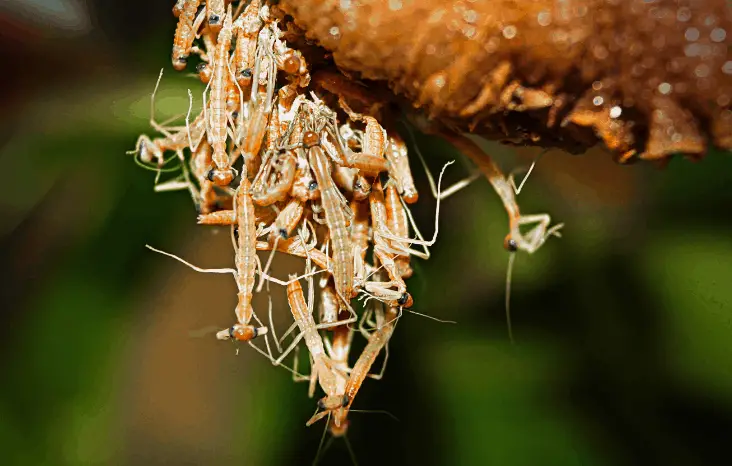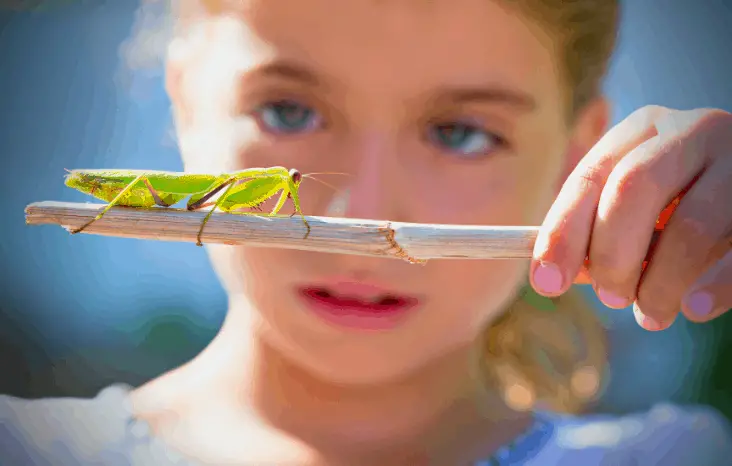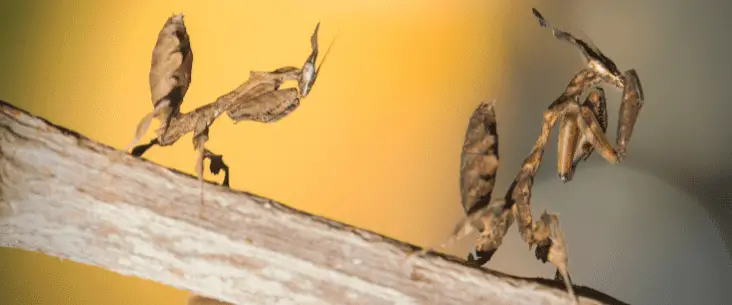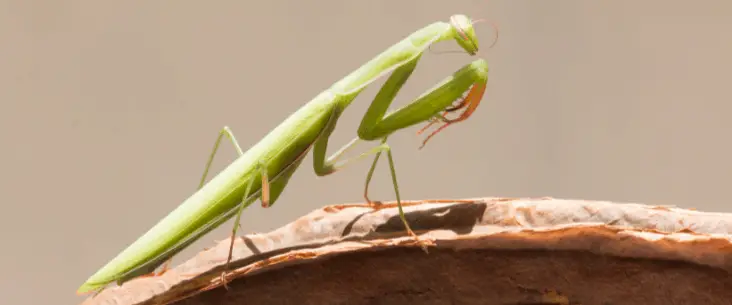You probably like to tell if your praying mantis is a male or a female. When you find one in your garden, when you keep them as a pet or when you have newborns. Obviously, it is necessary for the purpose of breeding with your mantises. Placing two females together will not have a happy ending, and at least no eggs. But, how do you tell if a praying mantis is a male or a female?
Determining the gender of praying mantises can best be done by counting the body segments of the abdomen. If you look from the underside you can easily count if your praying mantis has 8 body segments — which is a male — or 6 body segments when it is a female. However, there are also visual differences between the sexes.
Counting the body segments is the most reliable method to tell apart males from females. However, there are also visual differences in which you can easily determine if your praying mantis is a male or female. If you gain some experience with the care of your animals, you notice the differences quite easily.
Male or female praying mantis? Sexual dimorphism explained
Now, differences in appearance between males and females are very common in the world of insects. This phenomenon is called sexual dimorphism and simply means that there are morphological differences beyond the differences in their sexual organs. Normally these characteristics may include the body size, colour, markings, weight, body shape and certain appendages.
However, it is not only visual appearance that may be different. Often you’ll also see differences in behaviour and the way they live. With many mammals, there is almost no differentiation in appearance between the sexes. Think of dogs or rabbits. But with insects and other bugs, it is much more common that the animals are sexual dimorphous.
Before we talk about these variations between the gender, let’s first discuss the method that always ensures you have a male or female praying mantis — counting the body segments of the abdomen.

Segment counting method
Between males and females, there is a distinct difference in the number of body segments. Females have 6 body segments and the last body segment is larger and wider compared to males. Males, in contrast, have 8 body segments and all body segments are evenly distributed, whereas the last one(s) is much smaller.
This method can be used for all praying mantis species from the L4 nymphal stage onwards. Although it may not be so clear for every species to differentiate the body segments — especially with smaller species — with the help of a magnifying glass you are able to count the body segments. When they are adults it is much easier to count the segments.
Important notice: when you wish to count the segments, you should count from the underside of the animal. It is hard or even not possible to count the segments when you look at its back. Often the wings cover the segments as well or the abdomen is curled upwards. When you take a chopstick or skewer stick and let your mantis sit on it, you’ll have a clear vision of the underside of their abdomen. It is easiest to count that way. Or wait until your mantis is hanging on a twig for you to count.
Other visual differences between male and female praying mantises
When you gain experience working with a certain species, you quickly see other visual characteristics that tell you if it’s a male or female. These visual differences can be quite clear in some species, but also very subtle in others.
Besides that, most characteristics are only certain to say when the praying mantis is grown to adulthood and they are easiest to spot when you have a male and female next to each other to compare. When you see a single animal in the wild, it can still be hard to tell only by looking at these visual characteristics. In that case, count the body segments to know for sure.
But what are those differences then? When you want to determine the gender you look at the body size, body shape, antennae and wings.
Body size
Generally, males are smaller than females. This difference is not always clear between every species, but with species like the Orchid Mantis and the Bud-wing Mantis, you’ll see a real difference. The difference in size starts to be visible during the development of the nymphs. Eventually, you’ll see that some nymphs from the same ootheca (egg clutch) will grow slower than the others. Probably the smaller ones are the males.
However, this is only a clear characteristic when you can compare the male with a female, or if you have the knowledge about this species’ normal sizes. When you find a single specimen of an unknown species body size doesn’t say much.
Body shape
Another difference between males and females is that, generally, males have a more slender body shape compared to females. Females of most species have a larger abdomen and a larger thorax. Especially when you look at the abdomen, especially after some experience with praying mantises, oftentimes you can guess what the gender is.
With some species, there is a clear contrast in how the thorax is shaped. For example, with dead leaf mantises (Deroplatys desiccata) you can clearly see the development of the ‘shield’. This contrast is becoming even more and more pronounced when they get older. However, keep in mind that with some species these appendages and body shapes are the same in both sexes.

Antennae
The antennae can tell a lot about the gender of the mantis. Generally, males have longer and thicker (or feathery) antennae than females. This becomes more visible when the mantis reaches adulthood, but the development starts some stages earlier and with a trained eye you can already distinguish the males from the females.
Females have shorter and smoother antennae, and although the length is not always clear when they are still nymphs, the thickness becomes quite clear earlier on.
Development of wings
Now, the differences in wings can only be seen when they are adults. Wing development is only after the final moult. But when you see a praying mantis with wings you can at least say it reached adulthood.
Although both sexes can have wings, generally the males have relatively longer wings in ratio to their body size. With almost any species the wings of females do not reach further than the tip of the abdomen, and with many species, they do not even come that far. However, with males, the wings reach past the tip of their abdomen and stick out a bit.
Males have the ability to fly to search for a potential mate and have therefore more developed wings. Females are generally too heavy and won’t fly, although they can flap their wings and use them to glide.
Related read: Can A Praying Mantis Fly? A Closer Look At Their Wings
Colours and marking
Are male and female praying mantis different in colour? It is less common but some praying mantis species have colour variations between the male and female. If they do it is easy to determine its gender. Oftentimes the males are more colourful or have brighter markings than females. Those variations in colours between genders only become visible when they reach adulthood. However, because there is a natural variation in colours within species, sexing praying mantis using colour doesn’t really work. It is better to use the other visual characteristics to determine the gender of your mantis.
Behavioural differences
Differentiating genders by how your praying mantis behave is very difficult. At its best, you can only have an educated guess but you still need to look at the visual appearance or use the reliable segment counting method.
However, that doesn’t mean that there is no difference between males and females. Males can be shyer and more ‘wait-and-see’. For example, they may be more careful with grabbing food from a tweezer. Another behaviour that differs is that males fly when they have the space to do so.
Now, one behaviour that typically belongs to females is sexual cannibalism — the eating of the partner after mating. What is normal with praying mantis, females often eat the male after or even during mating, and when you are unlucky even before mating. Now, if you have only one mantis you don’t have to worry.

Now you have all the knowledge to determine the gender of your praying mantis. It is fun when you found a praying mantis in your garden to look at the different visual characteristics and practising the counting of body segments. Only that way, you become more experienced in telling if it is a male or female praying mantis.
But the conclusion remains the same. Only with the segment counting method, you can be absolutely sure if your praying mantis is a male or a female.
Much more to learn!
There is much more to learn about praying mantises. For example, learn more about sexual cannibalism: Why female praying mantises eats the male? You can find many more articles about mantises with plenty of practical tips to better understand and enjoy the keeping of these fascinating animals as pets.
Share this page!



